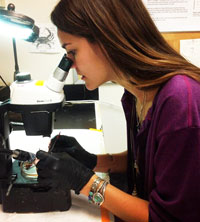
Name: Talia Head
Education: B.S. in Biology with a concentration in marine biology at Colorado State University
Hometown: Omaha, Nebraska
Career goal: Obtain a PhD, organize her own research lab and work as a professor.
Favorite Memory: Presenting at the SICB conference in San Francisco and visiting the UC Davis Bodega Marine Laboratory. “That was really cool to be able to go and practice presenting my research, but also hearing everything else everyone had done,” Talia explains. “And, after that we took a trip up to Bodega where there’s another laboratory that we kind of work with and we got to do some experiments there and see where they actually catch the crabs that they sent to us.”
Project: Co-localization of nitric oxide synthase (NOS) and molt-inhibiting hormone (MIH) in the eyestalk ganglia of the land crab, Gecarcinus lateralis, the green crab, Carcinus maenas, and the dungeness crab, Metacarcinus magister
Talia uses antibodies to detect the presence of different peptides, long strings of amino acids, in the eyestalks of the green shore crab, land crab and dungeness crab. Antibodies work in an animal’s immune system to identify foreign objects. Talia’s experiment uses secondary antibodies that glow when they bind to primary antibodies that attach to a desired peptide. Talia works with the Molt Inhibiting Hormone antibody, which detects MIH in the crabs’ eye stalks. Understanding how the Molt-Inhibiting Hormone works in a crab’s body gives scientists a bigger picture of how a crab controls molting. She also looks at the presence of nitric oxide synthase, an enzyme that produces the nitric oxide that helps control the levels of MIH. A crab is in intermolt stage, where they live most of their lives, when levels of MIH are high. Genetic instructions are carried out properly when other parts of the cell successfully make proteins and peptides. Identifying protein in the crab tissue shows that the process is working. “It’s kind of confirming that, yes, we know this peptide is part of this pathway and that it’s actually being expressed during these times,” Talia explains.
Primary Investigator
Undergraduate
- Matt Donovan
- Talia Head
- Hannah Jesberger
- Hanna Schulz
- Kent Schnacke
